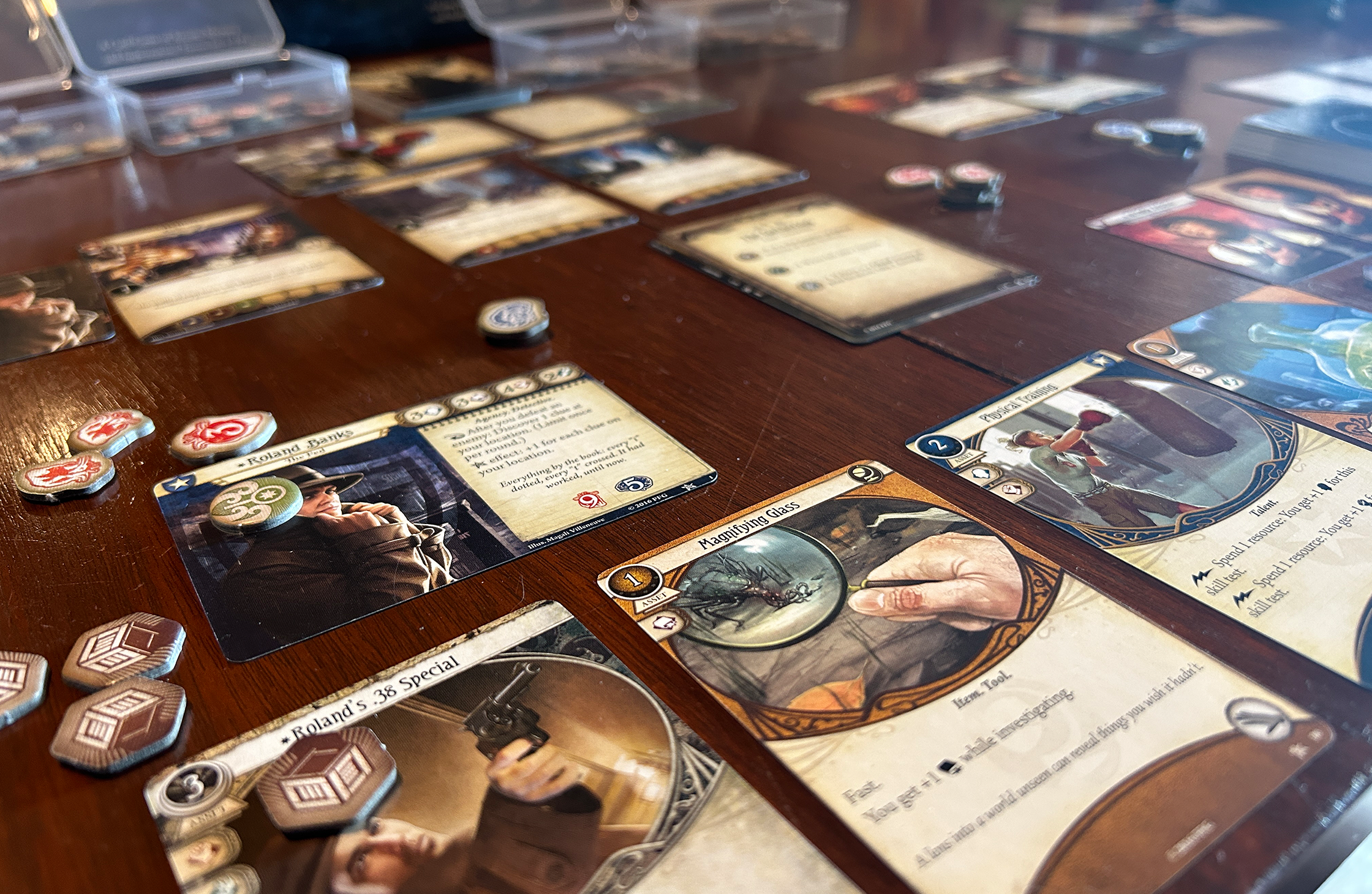Fantasy Flight does a lot of Lovecraftian horror games. Like, A LOT of them. Fortunately, most of them are very good and provide different enough experiences that having more than one of them in your collection isn’t a bad thing. For one, they’re all meaty, cooperative games, so if you want something where there’s a lot of working together with a high chance of failure, they’ll fit the bill. Want dice chucking? Grab Elder Sign. Want exploration and area control? Arkham or Eldritch Horror cover it. Investigation, puzzle solving, and deep stories? Mansions of Madness is wonderful (one of my favorites for sure). If you’re looking for emergent gameplay through deckbuilding without the collectability pitfalls of something like Magic: the Gathering, Arkham Horror: the Card Game (AH:tCG) is a great game to add to your collection.
The largest hurdle (at least for me) for most Fantasy Flight games is just figuring the things out. For AH:tCG, largely, the gameplay loops, and individual rules aren’t difficult, but the rule organization is extremely cumbersome during an initial playthrough. Seriously, watch a video tutorial; it makes life much easier. The rules reference is a solid in-game reference for all of the keywords used on the cards, but the how-to-play and campaign guides are seriously lacking when it comes to getting a handle on exactly how the game is played. Even the setup is inconsistent between the campaign guide and the learn-to-play book that specifically helps set up the first scenario in the campaign guide. Once you get going, it’s really smooth, but getting there….
There are a lot of little things to keep track of during gameplay, but the basic loop is this: Players (Investigators) do their things (like fighting, investigating, or playing cards); Enemies do their things (chasing Investigators or trying to eat them); the game enters a reset cards/draw to your hand/gain resources phase; then there’s a phase where the baddies get stronger and the failure end-state advances. Essentially, there are three ways to end a scenario: an Investigator dies, the Agenda completes (game ends in a failure), or the Acts complete (game ends in a success).
Failure by death is simple to grok. Investigators have a Health Pool and a Sanity Pool, and if either of those become empty, that Investigator dies and the scenario ends. Acts and Agendas are different. These basically describe the state of the game narratively, and as the Investigators advance through Acts by collecting clues or defeating monsters, their progress is highlighted. As Doom tokens are added to Agendas (either through a token being added at the end of a round or from cards that add them), the game gets more and more dangerous for the players. If either the Agenda or Act stack of cards is completed, the game ends.
The base game comes with three scenarios, each with its own set of Acts and Agendas. The details of success or failure are based on the scenario and how many of the scenario’s objectives were completed during the game (the campaign manual describes exactly how well the players did or didn’t do). Players progress through these scenarios to create a campaign. Additional campaigns can be purchased as expansions, but those go beyond the scope of this review.
The heart of what makes AH:tCG stand out amongst its siblings is the deckbuilding that occurs between games. Each character has a set of cards they can create decks from in the base box, so as you learn to leverage your character’s strengths, you can start altering your deck to take full advantage of them. This leads to what all good customizable card games should have: emergent gameplay. You’ll start seeing combinations of cards that are more powerful than the cards are individually, and you’ll be able to help mitigate some of the weaknesses that your character picks up as they delve into eldritch mysteries better left alone. Expansions add more cards to the available pool, as well as new characters that players can select at a game’s outset. As you learn the ins and outs of a scenario, you can bump up its difficulty and hit it with a more streamlined deck to see how you fare.
One way in which Fantasy Flight games always excel is the quality of components, and AH:tCG is no exception. The graphic design is really well done here, and the artwork library Fantasy Flight has to pull from is significant, thematic, and really helps set the mood for playing in a divergent 1920s New England. The chipboard used for all of the tokens is great, but putting a cloth bag into the box to help with the randomization tokens (a set of chips used to modify a scenario’s difficulty that are randomly pulled to affect skill tests) would have been appreciated for the price point.
If you’re interested in playing a deckbuilder but don’t want to have to worry about buying random booster packs or individual single prices, AH:tCG is a great option, and playing it is a great way to spend an afternoon. Each scenario can be played any number of times, but the real depth is in the expansion campaigns that you can pick up after the base game runs out of enjoyment. It’s a good amount of fun, and a fair challenge.
Designed by: Nate French, Maxine Juniper Newman, Matthew J. Newman
Player Count: 1–4*
Playtime: 60–120 Minutes
Time to Learn: 20 minutes (though there’s a lot of in-game learning)
Complexity: 3.5/5
Replayability: 5/5
MSRP: *$50 if you go for the 4-player set, but if you just want a 1–2 player experience, it’s $35
Written by Brendan Quinn, President of Tri-City Area Gaming. We’re out in the world again! Come play games with us at any of our regular monthly events.
All the links for Tri-City Area Gaming: tcag.carrd.co


